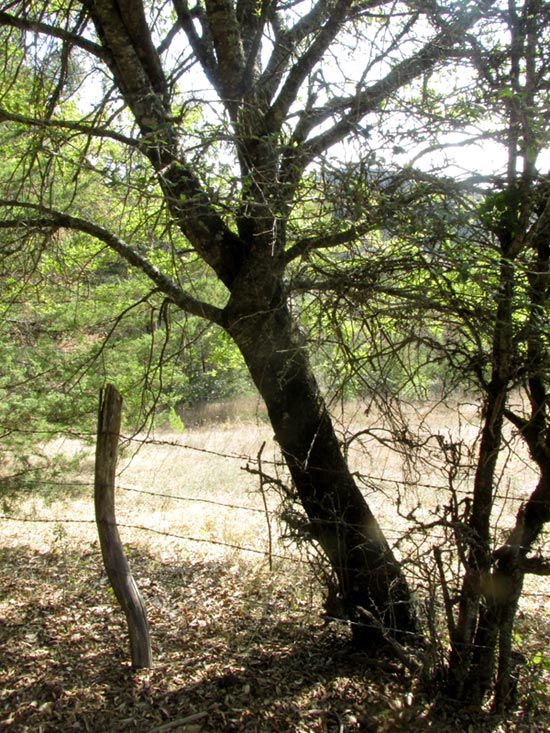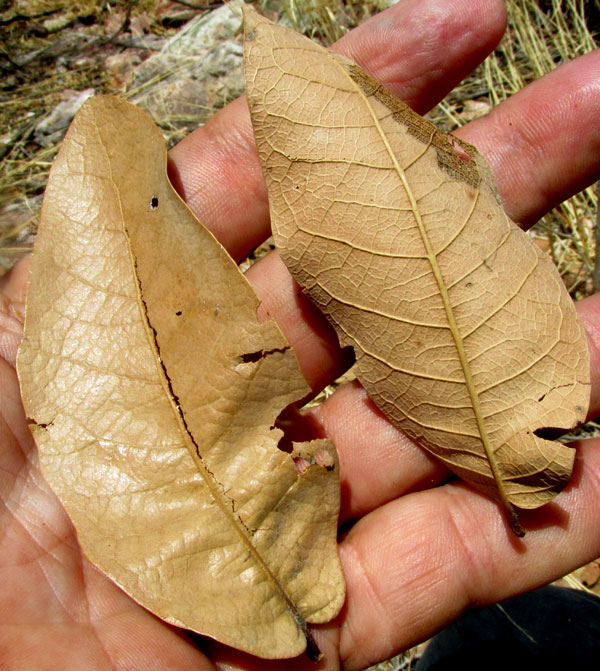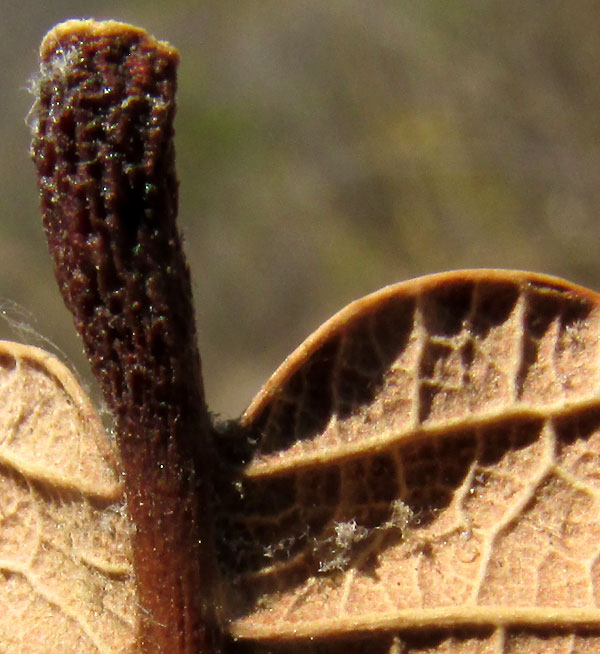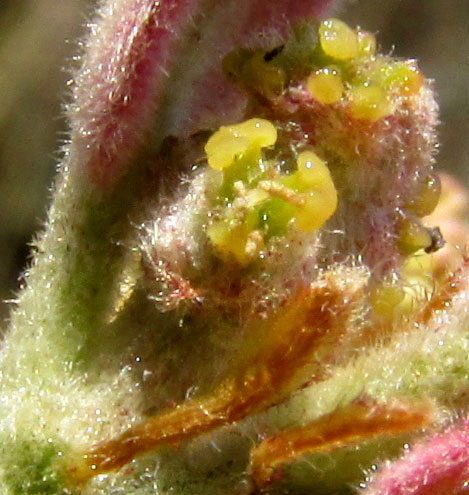Excerpts from Jim Conrad's
Naturalist Newsletter
entry from field notes dated April 15, 2022, taken in disturbed/reforesting borderline cloudforest within 1km of Valle de los Fantasmas, elevation ±2,320m (7600 ft), with limestone bedrock; about 40kms (24 miles), straight-line, ESE of San Luis Potosí, San Luis Potosí state, MÉXICO, (N22.06°, W100.62°)
"MEXICAN OAK" ISSUING LEAVES & FLOWERS

In these much-disturbed mountains, if there's a fencerow that hasn't been tended for some years, the kind of oak tree shown above might get started and begin offering shade to noonday cattle. Like most of the woody, deciduous species in this area, here at the super-dry end of the dry season, the tree is mostly leafless. However, along with the sporadic emergence of new leaves, it's issuing flowers. Below, you can see its aments of male flowers blowing in the wind.

Oak aments of male flowers vary in appearance from species to species, so it's worth looking at them closely, as shown below:

Each flower seems to bear about 6 stamens, and the flowers are widely dispersed along the very hairy rachis -- all good field marks. However, for identification purposes, even more important is what the acorns look like, and this tree still bore a few of last season's crop:

The acorns are more or less egg shaped, smallish, the cup half covering the nut, and they're attached to the twig with a very short stem, or no stem at all, and it's all a bit short-hairy. The hairiness extends to the newly emerging stems and leaves, too, as shown below:

The hairiness is definitely an important field mark, and the hairiness on the leaf's undersurface appears to clump in an unusual way. Also, notice the shallowly "eared," or cordate, blade bottom. The tip of the main leaf in the picture bears no bristle, but the tip of a blade behind the leaf, in the picture above and to the left side, bears a weak bristle. This was typical throughout the tree, some blades bristle-tipped, some not. Below, a closer look at the hairs on a leaf's undersurface shows that the hairs are branched, or "stellate," with what appears to be tiny dots or hair bases scattered among them.

All these features lead us to QUERCUS MEXICANA, the "Mexican" Oak, with quotation marks around "Mexican" because nowhere can I find the English name "Mexican Oak" applied to this species. However, this is the only oak of about 400 species of the oak genus Quercus bearing the species name mexicana, the species is endemic just to Mexico, and within Mexico it commonly occurs at elevations from 1600-3050m (5200-10,000 feet), from the northern states of Nuevo León and Tamaulipas to Chiapas in the south, and it occurs naturally in no other country. The species is worthy of bearing the English name Mexican Oak. In Spanish it's just called encino, which is a general term for "oak." Various indigenous names for it are known, like the Náhuatl Encino Tezahuatl, but such names disappear beyond the groups' boundaries.
Moreover, the name Quercus mexicana was given this species by none other than good old Humboldt and Bonpland, who published it in 1809, after their epoch-making exploration of the Americas, including a year-long visit to Mexico in 1803 and 1804. At that time, Mexico was known as the Kingdom or Viceroyalty of New Spain.
entry dated May 18, 2022, notes from a camping trip among hills about 7kms ENE of Tequisquiapan, Querétaro state, MÉXICO
elevation about 2020m (6600 ft), near N20.57°, W99.85°
"MEXICAN OAK" A SECOND VIEW
On certain steep slopes of hills around the village of La Higuera, very sparsely trees rise above the general level of the otherwise scrubby vegetation. Here at the very end of the dry season -- the rains are late this year -- most of the trees are leafless, but at least one had a slight greenish hue, so I went to take a look. You can see its gnarly trunk below:

Below the tree the remains of last season's acorns looked familiar with their small size, and the manner in which two acorns often appeared together atop a very short stem, the peduncle. The deep cups enclosed much, sometimes most, of the lower part of the nuts:

Last seasons crisp, leathery leaves lay in a thick, crunchy carpet below the tree:

The leaves' petioles were particularly short

Note that the above blade's undersurface is mostly hairless, yet where the main veins meet the midrib, and here and there across the undersurface, there are clusters of cobwebby hairs, as if earlier the undersurface had been velvety, but the hairs mostly disintegrated through the months of lying on the ground. On branches above, flowers and leaves were just emerging from their dry-season-dormant buds:

Amid such sprouting often tiny female flowers, the future acorns, were hidden amid a heavy coating of white hairs, but their yellow stigmas were exposed to the air, their glossiness suggesting the stickiness of receptive stigmas available for pollination.

All these details and others, including the long, slender, brown items in the picture above, below the stigmas, which are stipules that enlarge at their end and are rounded-tipped, not sharp, surprisingly lead us to the "Mexican Oak." It's surprising because over a month ago we saw this species -- reported above -- in San Luis Potosí state at a higher elevation and farther north than here, yet that tree was not only much more advanced with its flowering and leafing, but also its trunk and branches didn't display such low-lying gnarliness.
Possibly this is because the earlier location in San Luis Potosí was in a borderline cloud-forest environment at the edge of a mountain range, where the valley often was filled with fog/cloud with high humidity, while here the overall climate is much more arid and the slopes around La Higuera not only probably receive considerably less rain, but also are much more exposed to intense sunlight and desiccating winds.